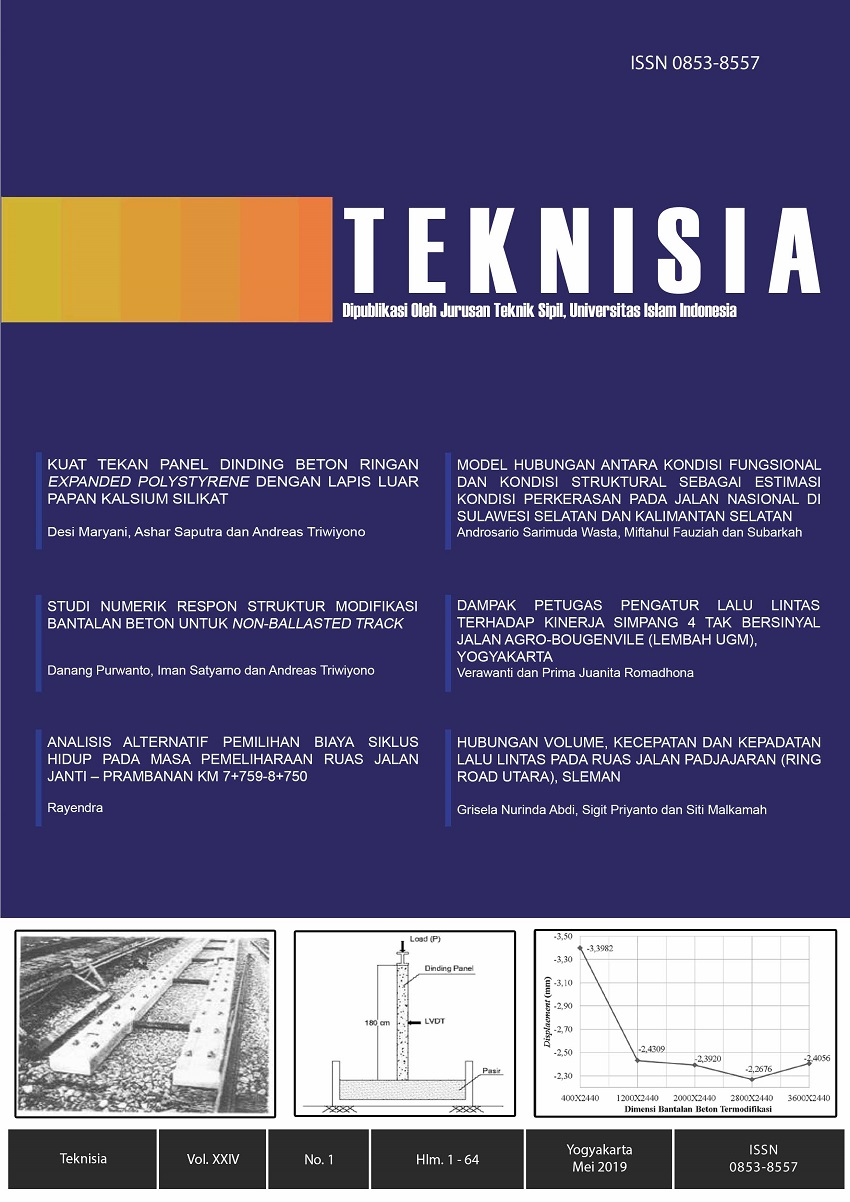Main Article Content
Abstract
Keywords
Article Details
Under the following term:
-
Attribution — You must give appropriate credit, provide a link to the license, and indicate if changes were made. You may do so in any reasonable manner, but not in any way that suggests the licensor endorses you or your use.
-
ShareAlike — If you remix, transform, or build upon the material, you must distribute your contributions under the same license as the original.
- No additional restrictions — You may not apply legal terms or technological measures that legally restrict others from doing anything the license permits.
References
- Aly, M.I., El-Shabrawy, M., Gendy, M. E., Turk, A. A., (2017). “:Analysis of Ballastless Railway Track Structures Over Soft Clays”. Malaysian Journal of Civil Engineering 29(2):145-156 (2017).
- Bowles, J. E. (1991). “Sifat-sifat Fisis dan Geoteknis Tanah (Mekanika Tanah)”. Jakarta: PT. Erlangga.
- Ministry of Railway of the People’s Republic of China. (2009). “Code for Design-speed Railway”.TB10621-2009.
- Eveld, C. (2001). ”Modern Railway Track”. Second Edition. Delft University of Technology.
- Kementrian Perhubungan Republik Indonesia, “Persyaratan Teknis Jalur Kereta Api”. No. PM 60 Tahun 2012.
- Kementrian Perhubungan Republik Indonesia. (2011). “Rencana Induk Perkereta Apian Nasional”. Jakarta Pusat.
- Madhkhan,, M., Entezam, M., and Torki, E. M., (2011). “Mechanical Properties of Precast Reinforced Concrete Slab tracks on Non-Ballasted Foundations”. Sharif University of Technology, Scientia Iranica.
- Manual for Railway Engineering. (1999). Voleme 2, Chapter 8, Part 27, American Railway and Maintence of Way Association. Landover, MD. USA
- Matias S. (2015). “NUMERICAL MODELING AND DESIGN OF SLAB TRACKS Comparison with ballasted tracks”. Instituto Superior Técnico, University of Lisbon Av. Rovisco Pais, 1049-001, Lisboa, Portugal.
- Michas, G., (2012). ” Slab Track Systems for High-Speed Railways”. KTH Architecture and the Built Enviroment.
- Riessberger K. (2001). “Frame-sleeper upgrade ballast-track”. WCRR Köln 2001.
- Sufaat S., dkk. (2018). “Pengaruh Prestre Terhadap Mekanika Struktur Slab Track CRTS II Pada Pembebanan Statik”. Seminar Nasional Infrastruktur Berkelanjutan 2018 Teknik Sipil dan Perencanaan.
References
Aly, M.I., El-Shabrawy, M., Gendy, M. E., Turk, A. A., (2017). “:Analysis of Ballastless Railway Track Structures Over Soft Clays”. Malaysian Journal of Civil Engineering 29(2):145-156 (2017).
Bowles, J. E. (1991). “Sifat-sifat Fisis dan Geoteknis Tanah (Mekanika Tanah)”. Jakarta: PT. Erlangga.
Ministry of Railway of the People’s Republic of China. (2009). “Code for Design-speed Railway”.TB10621-2009.
Eveld, C. (2001). ”Modern Railway Track”. Second Edition. Delft University of Technology.
Kementrian Perhubungan Republik Indonesia, “Persyaratan Teknis Jalur Kereta Api”. No. PM 60 Tahun 2012.
Kementrian Perhubungan Republik Indonesia. (2011). “Rencana Induk Perkereta Apian Nasional”. Jakarta Pusat.
Madhkhan,, M., Entezam, M., and Torki, E. M., (2011). “Mechanical Properties of Precast Reinforced Concrete Slab tracks on Non-Ballasted Foundations”. Sharif University of Technology, Scientia Iranica.
Manual for Railway Engineering. (1999). Voleme 2, Chapter 8, Part 27, American Railway and Maintence of Way Association. Landover, MD. USA
Matias S. (2015). “NUMERICAL MODELING AND DESIGN OF SLAB TRACKS Comparison with ballasted tracks”. Instituto Superior Técnico, University of Lisbon Av. Rovisco Pais, 1049-001, Lisboa, Portugal.
Michas, G., (2012). ” Slab Track Systems for High-Speed Railways”. KTH Architecture and the Built Enviroment.
Riessberger K. (2001). “Frame-sleeper upgrade ballast-track”. WCRR Köln 2001.
Sufaat S., dkk. (2018). “Pengaruh Prestre Terhadap Mekanika Struktur Slab Track CRTS II Pada Pembebanan Statik”. Seminar Nasional Infrastruktur Berkelanjutan 2018 Teknik Sipil dan Perencanaan.
